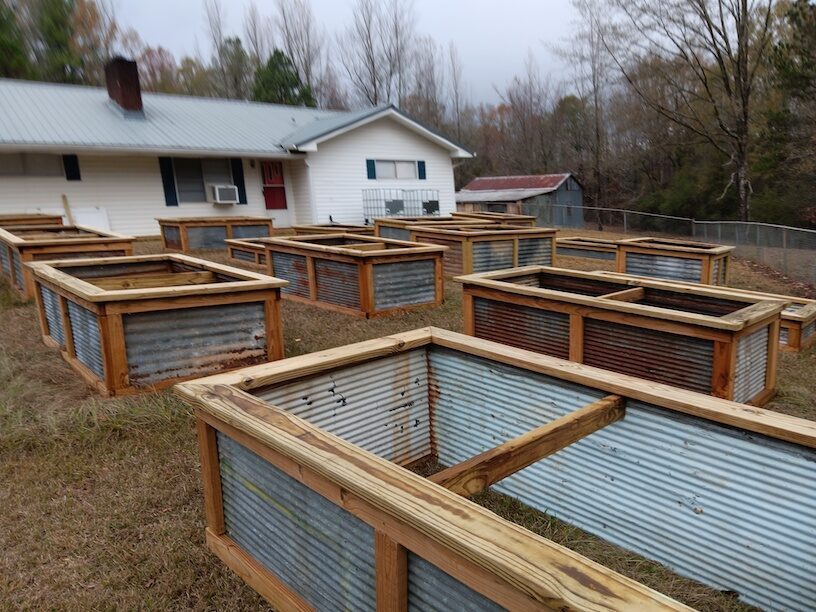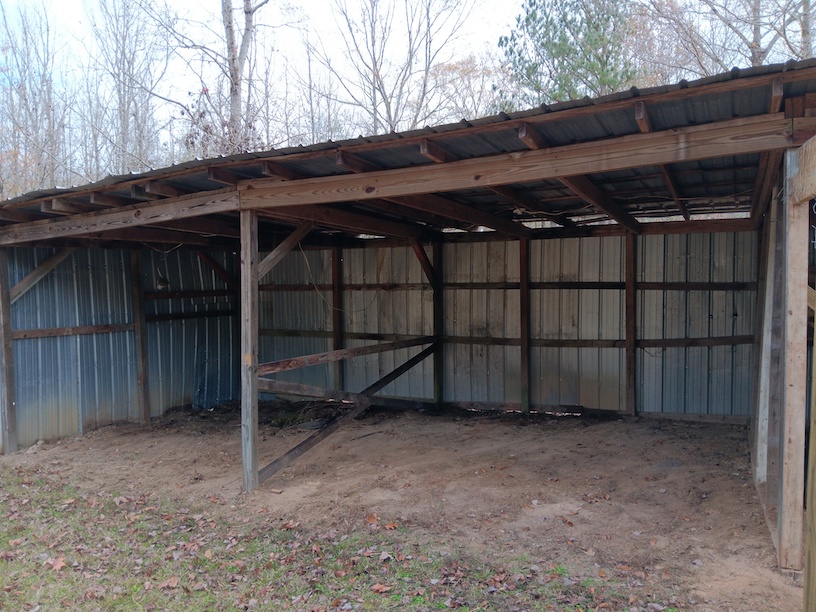9688 Hwy 19S, Kosciusko, MS 39090
Located just outside of Kosciusko, MS, Kozzy Acres is a bit of a unicorn.
Try to find a move-in ready mini-farm that’s set up to run a business.
Google “mini-farm for sale” or “homestead for sale” or “micro-farm for sale.” About 90% of the results will be for land (“Build your dream homestead/mini-farm!”).

You can purchase old farms, but you’ll be in for a costly major remodel of the house.
If you can find updated farms houses, they’re expensive, and there is no mini-farm setup. You might also find yourself in the middle of commercial farmland, with lots of fertilizer and pesticides sprayed by your neighbors each year. Or, you can find everything you need, but you’re too far away from any markets to sell your crops.
I’ve seen working mini-farm businesses for sale with impressive multi-year revenue numbers – but they start at $700,000 for three acres. One established 4-acre mini-farm is currently selling for $1.4 million, while another 3.5 acre business is selling for $1.2 million!
Kozzy Acres has a newly remodeled home, 1,200 square feet of sheds, chicken coops and a chicken run, a goat enclosure, pond, 20 raised gardens beds, 550 gallons of rain water collection capacity and a 12’ X 24’ greenhouse with automatic, temperature-controlled ventilation units.
In addition to living a sustainable lifestyle, you can run your own mini-farm business year-round. Kozzy Acres has been certified as a farm with the USDA’s FSA office, which means you can apply for NRCS grant money for a high tunnel, livestock fencing and other benefits.
Raised Garden Beds
There are currently 20 raised garden beds, and there are enough tin sheets in the back buildings to build another 10-12. Three beds have been placed in front of the house to give you an easy access herb garden. There is enough tin left over to build an additional 15 to 20 beds, based on if you’re building high or low beds.



Next to the beds in the main yard, the two, 275-gallon IBC totes are brand new and have never contained any liquids or solids, making them food grade rainwater harvesting collectors.
The Outbuildings
The three outbuildings were a busy place for the original owners. According to the family member who sold me the property, the buildings housed a cow, horse, pigs, chickens and even a boat. Her father was busy, especially in the large building, where he fixed cars, did woodworking and other activities.




You might use the buildings for livestock, feed, farm equipment, storage, preparing your crops for packaging and sale, curing potatoes and onions or whatever else you want to do with the space. Although the outbuildings have been significantly renovated, they still need some TLC (e.g., plugging roof leaks).
The large barn building (above) is approximately 40′ X 29′. The main room is 40′ X 16′ with the two side rooms 12′ X 24′ and 12′ X 15.
Chicken Coop
The new chicken coop features 18 nesting boxes, with room for more. The 14-guage wire protecting the run has been buried 6″ deep and there’s chicken wire over the run/yard to protect against avian predators. The interior area is approximately 12′ X 10′ (120 sq. ft.), while the outside run is 20′ X 15′ (300 sq. ft.).
If you want to let the chickens range in a larger area, you can easily fence in more space around the barn and sheds (an easy-to-do DIY project).



Got Goats?
The goat building is approximately 25′ X 13′ (325 sq. ft.), while the exterior pen/yard is 24′ X 12′ (290 sq. ft.). Using rain barrels, you can water your goats without needing to pump or haul water. A hose run from the spigot on the back of the house to the shed can also provide water. I discussed with the NRCS getting a grant for watering the goats using the pond and a new pipe-and-trough system. They’ll be happy to come out to the property to talk with you about it.




Thinking Horse or Cow?
This space is approximately 23.5′ wide X 12′ deep (280 sq. ft.). Putting a gutter and rain barrels on the back of the stable and chicken shed will let you bring fresh water to your livestock (including the goats) at no expense, and without having to pump or haul water.


Storage Shed
This structure (below) sits on the opposite side of the wall from the chicken coop. You can use it to store your lawnmower, fertilizer, feed or other items. You can hook up and pipe water from rain barrels through the wall on the right, directly to the chickens, horse or cow. You can set up enough barrels on all of these buildings to water your goats, as well.

The original owner completely wired all three buildings and even had a circuit box put in the main building. The Entergy rep said the box looked to be still in good shape. He said most of the wiring looked good, but much needed to upgraded. During my electrical update of the main house, I had my electrician disconnect the main line from the house that feeds the outbuildings until they could be looked at by the new owners.
After you’ve settled in and have decided what you want to do with the outbuildings, you can hire an electrician to talk over your options. Much of the wiring in the outbuildings probably needs to be re-done to make it safer (although it worked for the original owner for decades), but the template is there. I’ve replaced many of the old boards and sheets of tin to make all of the structures safer and plug most roof leaks, but you’ll probably also want to inspect the the structures to see if you want to shore up a few more areas.
Dog Run
The house is surrounded by chain link fence for your pooch, whether it’s a LGD or just a lap dog.



The Pond
The charming pond on Kozzy Acres can provide a family a place to enjoy the surrounding scenic beauty, or could be used to stock fish or to water livestock. According to one contractor who visited the farm, he played on the property as a youngster, the pond had a dock and the kids took a small boat out to the center. The daughter who grew up on the farm told me she and her girlfriend used to angle for catfish.

The berm will need some work to fix some seepage and bring it back to its former glory (some tree cutting and bulldozer work), but once it’s done, NRCS representatives who visited the property told me you might be able to stock the pond with up to 200 catfish, bass or other fish!
The Greenhouse
The 12′ X 24′ greenhouse is brand new. Technically, it’s properly referred to as a high tunnel because it does not have cooling or heating equipment. But, I’m referring to it as a greenhouse throughout the website because that’s the term most people use. It does feature UV-resistant plastic, and two, temperature-controlled vents that open and close automatically when the interior reaches the temperature range you pre-select.




The greenhouse has not been permanently anchored (poles cemented into the ground), in case you want to place a much larger greenhouse (with your free USDA money!*) in this location.
Because of the height of its top, the pole barn has enough sunlight that you can also convert it to yet another greenhouse. The pole barn originally had electricity and water running to it, and you should be able to re-connect those with the help of a professional.
*Check out the free money available for a greenhouse from the USDA NRCS.
Grazing Land
If you’re planning on keeping livestock, there’s plenty of cleared land for that. And — the USDA will give you money to triple your fencing and bring water (a trough?) to your herd or flock. Check the Free Money page for more information.


Hunting and Fishing
Visitors these past few months have seen deer, rabbit, coyotes and game birds on the pond. Once the pond is restored, you can stock it with the fish of your choice (to feed your family or sell to restaurants, at the farmer’s market or to other customers).
It’s legal to hunt on the property, and at one point, the property was used as a deer camp by local hunters. The pole barn (below) was set up (and can be re-activated) with water and electricity for processing your game.







A Rare Property
I searched more than 300 properties across the U.S. that would meet the requirements for a sustainable homestead and realistic mini-farm business (enough acreage and close to an adequate number of potential commercial customers), and this was one of only a few.
- It has a newly remodeled house.
- It has high-speed internet access.
- It has multiple acres for planting.
- It has a protected chicken coop and goat enclosure with fencing for both.
- It has a horse or cow stable.
- The 1,200+ sq. ft. of outbuildings can be used for livestock, curing plants like onions and potatoes or storing your farm equipment.
- It has a pond (which can be stocked with fish).
- It has a greenhouse.
- It is zoned agricultural.
- It’s near three good-size cities with loads of potential commercial customers.*
- It has a second septic tank and propane tank on the property if you wish to add another dwelling or bring a trailer/mobile home onto the property.
Google “mini-farm” for sale and see what you can find that’s comparable. This is it!
*Jackson, Meridian, Starkville, with Kosciusko, Philadelphia and Louisville 15-30 minutes away.
If you choose to run an organic farm, you’ll want to get Kozzy Acres certified organic. That should be a simple process (you might be able to self-certify). Make sure you know the requirements before you commit to this type of growing. As far as I know, no chemicals fertilizers or pesticides have been used on the farm for the last several years (the property has not had a garden or other crops for many years).
The raised garden beds are made with pressure-treated lumber, so those beds won’t qualify as organic. They should be safe for you and your family, or selling as non-organic crops. Here’s more on that from the University of Maine Cooperative Extension (today’s pressure-treated lumber is made using different chemicals than in years past).
A Second Residence?
At one time, the house had two trailer residences. There’s a second septic tank on the property, along with a second water line and meter. There are two additional electric transformers on the property, which could power two or three trailers or other structures, according to a rep from Entergy who visited the property. The cost to re-activate them would be about $30 each, he said.
If you wanted to hire a farmer to run your farm for you, you could bring a tiny house or trailer onto the property and run electric, gas, water and wireless to his or her trailer.
Yet another trailer sat in the lower portion of the front of the property, and there is a second septic tank in that area if you’d like to place someone (a caretaker or farmer?) there. There was also a construction trailer parked on the property near the propane tank that was used for storage (see photo below).


The “pole barn” covered the original owner’s camper and had water and electricity running to it. Next to it was a trailer that had a water line and electricity run to it. You can re-activate the water meter for about $500 and power from the transformer for about $30 if you want to put a trailer on the property in that location.